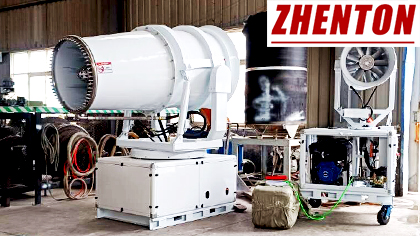Misting Cannon Features Primary and Secondary Nozzle Rings for Powerful Water Throw and Fine Atomization of Water Molecules to Bring Down Fugitive Dust
When Selecting Dust Suppression Equipment for Demolition Sites,Consider Factors Like:
Site Size and Layout:Larger Sites May Benefit More from High-Powered Misting Cannons with Extensive Coverage.
Nature of Dust:Specific Contaminants Like Asbestos or Silica May Require More Targeted Solutions
Portability Needs:Mobile Solutions Such as Those Provided by ZT Are Advantageous for Sites Requiring Frequent Repositioning

Two Commonly Used Dust Suppressants Suitable for Fog Cannon Applications Are Calcium Chloride and Magnesium Chloride.These Hygroscopic Materials Attract Moisture from the Air,Enhancing Their Dust Control Effectiveness over Extended Periods.When Used in Conjunction with Fog Cannon Machines,These Suppressants Optimize Dust Suppression Efforts,Particularly in Dry and Arid Conditions.
Fog Cannon Machines Fall Under Mechanical Methods of Dust Suppression.They Operate by Generating a Mist that Binds with Dust Particles,Making Them Heavier and Promoting Their Settlement.This Approach Is Highly Effective in Environments Where Traditional Methods Like Water Sprinklers or Chemical Dust Suppressants May Not Be Sufficient.Effective for a Wide Range of Particle Sizes (0.1 to 1000 Microns),Can Cover Large Areas,and Reduce PM10 Dust Levels Significantly
These Technologies Can Be Used Individually or in Combination Depending on the Specific Dust Control Requirements and Environmental Conditions of the Application.
1.Fog Cannons:These Devices Use High-Pressure Water or Other Liquids to Create a Fine Mist or Fog that Captures and Suppresses Dust Particles in the Air.
2.Dust Suppressants:Chemical Products Applied to Surfaces or Materials to Reduce Dust Formation.They Can Act by Binding Dust Particles Together or by Preventing Them from Becoming Airborne.
3.Enclosures and Barriers:Physical Barriers or Enclosures Around Dust-Generating Activities to Contain Airborne Particles.
4.Ventilation and Air Filtration Systems:Mechanical Systems that Capture and Filter Dust-Laden Air to Remove Particles Before They Are Released into the Environment.
5.Soil Stabilization:Techniques Used in Construction and Mining to Stabilize Soils and Prevent Dust Generation from Unpaved Surfaces.
6.Electrostatic Precipitators:Devices that Use Electrostatic Forces to Remove Dust Particles from Gas Streams.
7.Wet Dust Collection Systems:Systems that Use Water or Other Liquids to Capture and Remove Dust Particles from Gas Streams.
8.Personal Protective Equipment (PPE):Including Masks,Respirators,and Protective Clothing Worn by Individuals to Prevent Inhalation or Contact with Dust Particles.










